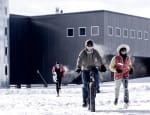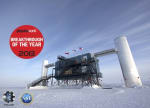Out with the old, in with the new. This might pertain to many things as one year changes to the next, but at the South Pole it also applies to the South Pole marker, which indicates the spot of the geographic South Pole. […]
News
Week 52 at the Pole
The Race Around the World, an approximately two-mile course at the South Pole, is one that some folks take seriously, with planning and preparations aimed at bringing them across the finish line first. After all, the prize, an extralong shower, is something anyone living at the South Pole station would covet, as shower time is rationed there. […]
IceCube looks to the future with PINGU
PINGU, the Precision IceCube Next Generation Upgrade, proposes a extension inside the current IceCube array designed to measure the mass of the three known neutrino types. […]
Week 51 at the Pole
The summer season isn’t long at the South Pole, from about late October through early February. Folks typically arrive in shifts, spending a few weeks, give or take, working at the Pole. But delays are common, whether coming or going—and when they happen around the holidays it can be all the more frustrating. […]
Week 50 at the Pole
It was a week filled with movement outdoors. First up, snow needed to be moved. A survey was done of snow depths over the IceTop stations, and excess snow was removed. You can see the IceCube crew in the snowcat, or “pisten bully,” (above) while out on their rounds. […]
Week 49 at the Pole
It looks like IceCube winterover Ian Rees is practicing a good luge position, but he’s just taking advantage of his perch to capture photos. He’s lying atop some boxes bearing new equipment as part of an extensive server upgrade. This photo gives the sense of peace and quiet, but they’re moving and the flags are up, so with a little effort you might imagine there to be some wind noise. […]
IceCube awarded the 2013 Breakthrough of the Year
The IceCube project has been awarded the 2013 Breakthrough of the Year by the British magazine Physics World. The Antarctic observatory has been selected for making the first observation of cosmic neutrinos, but also for overcoming the many challenges of creating and operating a colossal detector deep under the ice at the South Pole. […]
Neutrino telescope shines light on the last glaciation
In a paper recently published in the Journal of Glaciology, the IceCube Collaboration presents a study of South Pole climate over the past 100,000 years, using high-resolution 3D laser images of the ice sheet. […]
Week 48 at the Pole
That’s IceCube winterover Ian Rees (facing) near the drill while it’s being prepared to access a rod well, which is a deep cavity used to melt ice for drinking water. Rod wells are named after Paul Rodriguez, an Army engineer who developed them while at Camp Century in Greenland in the early 1960s. […]
A new summer for IceCube: the polar season that may have not happened
This austral summer, on November 4, Ian Rees was the first IceCuber to reach the Amundsen-Scott station, after a long trip from Boulder, Colorado. From now until the end of the IceCube polar season, 20 people will fly to the Pole from Madison, Maryland and Delaware in the US, but also from Canada, Germany, Sweden, and Belgium. […]









